On the Decorations of the Garden-Pavilion in the Grounds of Buckingham Palace
[Jameson, Anna. Introduction to The decorations of the garden-pavilion in the grounds of Buckingham palace. Ed. Ludwig Grüner. London: John Murray, 1846. 6-10.]
By Mrs. Jameson.
WITHIN the last few years, owing to a. number of concurrent circumstances, public attention has been directed, to the combination of Decorative Painting with Architecture, after the examples left to us by the great Italian painters and architects of the Sixteenth Century. The introduction, or rather the revival, of Fresco Painting in this country has become, in connexion with a great national monument, a topic of general interest, an affair of national importance, and no longer merely a matter of private or artistic speculation. While curiosity and interest were thus strongly excited towards the subject, and our artists were occupied in considering its feasibility and the particular management of a vehicle almost unknown to them, it occurred to Her Majesty and His Royal Highness Prince Albert, that it would be well to have the experiment made on a small scale, yet under circumstances which might lend it a more than common interest, and at the same time offer to some of our first artists at once a high motive and a fair opportunity to try their powers in this new old method. The idea was surely a happy one; and not the less seasonable that every one who had considered the subject (at least every one who understood it), felt that it was a method which presented particular difficulties to some of the ablest and most distinguished of our painters, whose habitual style of execution, whose aim in point of treatment of their subject and effect, had been precisely the reverse of what is required in Fresco.
The application of Fresco Painting, to the decoration of architecture, demands the adaptation of parts to a whole; a preconcerted mode of treatment, in which the painting shall seem to be in unison with the original design of the edifice; the harmonious combination of many minds, working under the direction of one mind, to one purpose: and, with regard to the mechanical part of the process, it requires much thought and study in the preparation of the materials, and great care and precision, as well as great rapidity, in the execution.
The advantage of mingling in the interior decoration of a building isolated figures and historical subjects with arabesque ornaments, has been proved to be twofold. If the locality be small, the space appears to be enlarged to the eye by the involution and continuation of multiplied and varied forms and colours; while, if the dimensions be large, the interest is concentrated by the presence of a leading idea, connecting all these separate compartments and all this maze of variety into one harmonious whole. The wild and dream-like arabesques are like vague, delicious music; the historical subjects form resting-places for the fancy; and the two in combination are like the lyrical drama,--action, sentiment, and melody woven together. [end of page 4]
A small Pavilion, or summer-house, in the grounds behind Buckingham Palace, was selected by Her Majesty as the locality in which this interesting Experiment was to be tried. It may be remembered, that some of the most beautiful examples of Italian decorative art are to be found in Garden-houses and the appendages to Villas, and that some of the most celebrated compositions in the world were Decorative Pictures. Raphael's "Galatea," for instance, is on the wall of the Villa Farnesina. Guido's "Aurora" is on the ceiling of a summer-house in the gardens of the Rospigliosi Palace.
It is perhaps to be regretted that this little Pavilion, originally intended only for a simple cottage, was not constructed for the purpose of being thus distinguished. There were certain disadvantages and difficulties arising out of the original construction which had to be overcome, and some that could never be wholly conquered; but at length, after successive ingenious alterations it assumed its present form. It is a small edifice on the summit of an eminence, overlooking the piece of water. The external appearance is picturesque and fantastic, without any regular style of architecture. The interior consists of three rooms and a kitchen. The principal apartment is an octagon, 15 feet 8 inches by 15 feet 9 inches; and from the floor to the center of the vaulted ceiling, 14 feet 11 inches in height. This room opens on each side into another of smaller size, 8 feet 10 inches by 9 feet 7 inches, and 12 feet in height. The original intention was to decorate only the center room, and the poem selected for pictorial illustration was "COMUS," in itself, like an exquisite many-sided gem, presenting within a small compass the most faultless proportion and the richest variety. It would have been difficult to have made a happier or more appropriate choice. The locality was not fitted for sacred, or epic, or heroic compositions, or grave history, or graver tragedy; "Comus," at once classical, romantic, and pastoral, with all its charming associations of grouping, sentiment, and scenery, was just the thing fitted to inspire English artists, to elevate their fancy to the height of their argument, to render their task at once a light and a proud one; while nothing could be more beautifully adapted to the shades of a trim garden devoted to the recreation of our Lady Sovereign, than the chaste, polished, yet picturesque elegance of the poem considered as a creation of art. Under any other circumstances, the same silver thread of character and sentiment ought to have been carried on unbroken through the three rooms: the "Penseroso" on one side, the "Allegro" on the other. The concord would then have been perfect: but here, variety was the object, for the sake of fully carrying out the experiment. The room to the left is therefore dedicated to the purely romantic,--to Sir Walter Scott. That to the right is purely classical, and all the ornaments Pompeian. Thus, within a small compass, three different styles of decoration, the Cinque-cento, the Antique, and the Romantic, have been placed in proximity, and may be brought into immediate contrast and comparison.
Having given a general idea of the whole, we will now go into the detail of each apartment.
The Central Room is an octagon: of the eight sides, five are occupied by windows and the glazed entrance; three others by the doors opening on the two side-rooms, and by the fire-place, over which is a large mirror, reflecting the whole.
The roof rises into a dome, sustained and divided by eight ribs; and in each compartment is a circular opening, with sky background,--those on the west side representing midnight, with its star, and those on the east, the approaching dawn. A rich cornice runs round the room; and below the cornice are the eight lunettes, containing the frescos, by eight different painters. Each lunette measures 5 feet by 2 feet 6 inches, except Mr. Stanfield's, which measures 6 feet; and over each is a tablet, on which is inscribed, in gilt letters on a brownish-red ground, the particular passage of the poem which has suggested the subject of the painting below. [end of page 5]
In the selection of the subjects the artists were left free, and the result proves the absolute necessity of a presiding mind, where it is intended that diversity of parts shall blend into a well-ordered whole; for here we find that three of the subjects are nearly similar, yet presenting, even in their monotony, a sort of inconsistency, for we have three different Ladies on three different chairs; while two subjects are absolutely identical, Comus driven out by the brothers--and this, too, in the illustration of a poem which so abounds in suggestive imagery, that almost every line is a picture! A farther inconvenience, resulting from this deference to the individual taste and arbitrary choice of each painter, is, that the pictures do not form a regular series, and that the same incident is twice repeated. Had the painters worked together, with a mutual understanding of their task as a whole, this would not have occurred; and it is noticed here, because every observer, even the most careless, will perceive an error which seems at first view unaccountable, but which may, with some forethought, be avoided in future undertakings of this kind.
The subjects in the lunettes succeed each other in the following order, beginning over the door by which we enter from the terrace:--
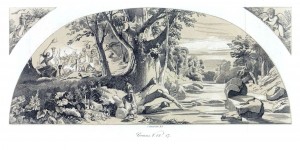
I.—STANFIELD, R.A.
Yet some there be that by due steps aspire
To lay their just hands on that golden key,
That opes the palace of Eternity.
To such my errand is.
Comus, v.12-17.
Landscape; a forest scene, through which a torrent broken by rocks and pebbles flows towards the foreground. The attendant spirit is seen in his shepherd guise, leaning on his crook, in a meditative anxious attitude: while in the background, through the glade, we see the rabble rout of Comus engaged in their nocturnal revels. The spandrils represent, on the right, a cherub weeping; on the left, a fiend exulting.
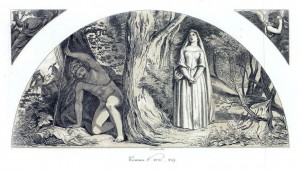
II.--T. UWINS, R.A.
This is the place, as well as I may guess,
Whence even now the tumult of loud mirth
Was rife.
Comus, v. 200-219.
Comus and the Lady. She is standing "near a huge oak, the center of the grove," as one meditating. Comus stands half hidden by the foliage, and listening to her soliloquy. In the spandrils a Seraph looks down with anguish; and a Satyr with triumph.
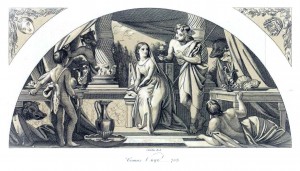
III.--C. LESLIE, R.A.
Hence with thy brew'd enchantments,
Hast thou betrayed my credulous innocence
With visor'd falsehood and forgery?
Comus, v. 696-795.
The Lady, spell-bound in the chair, repels Comus, who offers her the enchanted goblet. A Bacchante reclining and a young Satyr are in the foreground. In the spandrils, white antique masks and white flowers. [end of page 6]
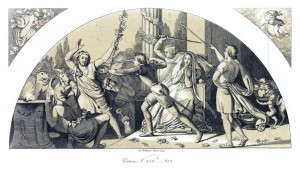
IV.--SIR WILLIAM ROSS, R.A.
What! have you let the false enchanter 'scape!
O ye mistook; ye should have snatch'd his wand,
And bound him fast.
Comus, v. 812-816.
The two brothers with drawn swords drive out Comus and his crew. The attendant spirit stands in front; the Lady is seated behind. In the spandrils, a Bacchante and a Diana.
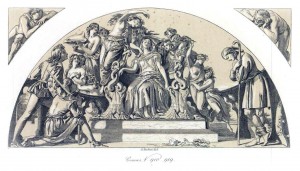
V.--DANIEL MACLISE, R.A.
Brightest Lady, look on me;
Thus I sprinkle on my breast
Drops, that from my fountain pure
I have kept, of precious cure.
Comus, v. 910-919.
The Lady, spell-bound, not only "in stony fetters fixed, and motionless," but asleep or in a trance, is seated in the marble chair. Sabrina and her attendant nymphs are hovering round her. One nymph presents in a shell the water "from the fountain pure." Sabrina, bending over the Lady, is about to sprinkle her and to pronounce the "dissevering charm." In front stand the two brothers and the attendant spirit. In the spandrils, two of the deformed "rabble rout" look down in affright.
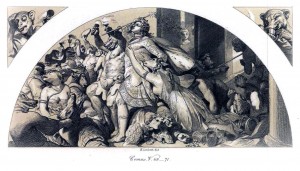
VI.--EDWIN LANDSEER, R.A.
__ Their human countenance,
Th' express resemblance of the gods, is changed
Into some brutish form of wolf or bear,
Or ounce or tiger, hog or bearded goat.
Comus, v. 68-71.
The same subject as No. IV., very differently treated. Comus, surrounded by his crew, is terrified by the approach of the brothers, who appear behind in the act of rushing upon them. A Bacchante, with a beautiful female form, and the head of a hound, has thrown herself in affright upon the arm of Comus. Other monsters, half brute, half human, in various attitudes of mad revelry--grovelling, bestial insensibility--confusion and terror--are seen around him; the pathetic, the poetical, the horrible, the grotesque, all wildly, strangely mingled. In the spandrils are two heads--a grinning ape, nod a bear drinking.
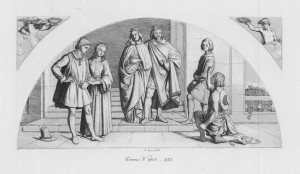
VII.--W. DYCE, A.R.A.
Noble Lord and Lady bright,
I have brought ye new delight.
Here behold, so goodly grown,
Three fair branches of your own.
Comus, v. 968-975.
The attendant spirit, kneeling, presents the liberated Lady and her two brothers to their noble parents, who come forth from their "state" to receive their princely progeny. In the spandrils, two guardian angels present crowns of white roses and myrtle.
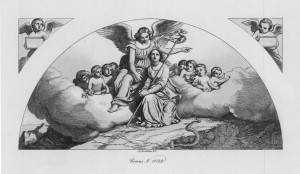
VIII.--C. L. EASTLAKE, R.A.
______ If virtue feeble were,
Heav'n itself would stoop to her.
Comus, v. 1022.
Virtue, ascending to the "sphery chime," faints on the steep and rugged path. A seraph, with a [end of page 7]
countenance beaming with tenderness and pity, bends from above to encourage and to aid her. Angels on each side, holding the lily, the emblem of purity, are leaning from the clouds to welcome her; while Vice, under the semblance of a serpent, is seen gliding away. In the spandrils are two pensive cherub heads, with an expression of adoration.
Beneath the lunettes are panels adorned with arabesques, in harmony with the main subjects. Over each door are winged panthers, in stucco, with a head of Comus, ivy-crowned, between them. The ivy and the vine predominate amid the wreaths of many-coloured flowers and fruits, the masks and grotesques, which adorn the panels and friezes. Beneath each window is the cypher of Her Majesty and Prince Albert, encircled with flowers. The medallions, in bas-relief, on the pilasters, contain figures and groups from a variety of Milton's Poems:--
- EVE.
- ADAM.
- ITHURIEL.
- LUCIFER.
- EVE RELATING HER DREAM TO ADAM.
- ADAM CONSOLING HIS CONSORT.
- L'ALLEGRO.
- IL PENSEROSO.
- THE BRIGHT MORNING STAR--DAY'S HARBINGER.
- SABRINA RISING.
- SABRINA DESCENDING.
- SAMSON AGONISTES.
These, like the rest of the stucchi in this room, have been designed and modelled by W. G. NICHOLL.
In the semicircular medallions above and below, the snake, half hidden; the toad, suggestive of evil; the cormorant, goats, panthers, and butterflies, form the appropriate ornaments, all having some relation to the subject of the central medallion.
The intermixture of the ornaments and medallions in relief is fill idea borrowed from the best era of Italian decoration. It was first adopted by Raphael and his scholars in the Loggie of the Vatican, and suggested by the ornaments in the Baths of Titus.
On the two pilasters of the white marble chimney-piece are figures, in bas-relief, representing the Lady and the attendant Spirit. They are the works of S. B. STEPHENS.
Two richly carved and gilt doors open from the central apartment into rooms on the right and left. The room on the right is decorated in the Pompeian style; all the ornaments, friezes, and panels being suggested by, or accurately copied from, existing remains, except the coved ceiling, which is invented by A. AGLIO. This room may be considered as a very perfect and genuine example of classical domestic decoration, such as we find in the buildings of Pompeii,--a style totally distinct from that of the Baths of Titus, which suggested to Raphael, and his school, the rich arabesques and ornaments in painting, and in relief, which prevailed in the sixteenth century, and which have been chiefly followed in the other two rooms.
The room on the left has been decorated in what may be called the Romantic style. The subjects are all taken from the novels and poems of Sir Walter Scott. The walls of this room, to the height of twelve feet, are painted in imitation of grey marble, with such taste and fidelity as to deceive the most practised eye. Above this marble wall, which has a very chaste and cool effect, runs a decorated frieze, in twelve compartments, three on each side: of these, the central compartment is formed of a bas-relief, in white stucco, on a dark-blue ground; and to the right and left are festoons of flowers, richly coloured, and surrounding small landscapes, in frames, illustrative of the scenery of the novels. These have been painted by E. W. DALLAS, from L. GRUNER'S original sketches. They represent:--
- MELROSE.
- ABBOTSFORD.
- LOCH ETIVE.
- DRYBURGH ABBEY.
- CRAIG NETHAN.
- LOCH AWE.
- AROSS CASTLE.
- WINDERMERE LAKE.
[end of page 8]
The four bas-reliefs are from the poems of Scott. The first is from "Marmion." Clara recognising Wilton on the field of battle. By HENRY TIMBRELL.
She raised her eyes in mournful mood,
Wilton himself before her stood!
The second, from the "Lord of the Isles." By the same.
He raised the page, where, on the plain,
His fears had sunk him with the slain.
The third is from the "Lay of the Last Minstrel." Thomas of Deloraine, in obedience to the Lady of Branxholme, enters tile tomb of Thomas the Rhymer, and carries off the magic book. By J. BELL.
Then Deloraine in terror took
From the cold hand the mighty book.
The fourth is from the" Lady of the Lake." Roderick Dhu overcome by the Knight of Snowdon. By the same.
He falter'd thanks to heaven for life,
Redeem'd, unhop'd, from desperate strife.
In the lunettes, over each bas-relief, is the verse or line which suggested the subject, in gilt letters, on a red ground, amid a rich arabesque of flowers.
In the other eight lunettes are subjects from the novels, painted by five different artists. They may be taken in the following order, beginning with that on the left hand next to the entrance:--
I.--Scene from "St. Valentine's Eve."--Catherine Glover, on the morning of St. Valentine, approaches to kiss the lips of the Smith, who is sleeping in his chair . . . . H. J. TOWNSEND.
II-.-Scene from "The Monastery."--The death of Julian Avenel . . . . C. STONHOUSE.
III.--Scene from "The Talisman."--Edith Plantagenet drops the rose-bud at the feet of the Kneeling Knight . . . . . J. SEVERN.
IV.--Scene from "The Abbot."--Roland Graeme, when an infant, is rescued by the deer-hound . . . . . C. STONHOUSE .
V.--Scene from "Ivanhoe."-- Brian de Bois Guilbert and the Prior Aylmer, travelling through the forest, are met by Gurth, the swineherd, and Wamba . . . . . RICHARD DOYLE.
VI.--Scene from "Kenilworth."--Queen Elizabeth, dragging Amy Robsart from her retreat, confronts her with the dismayed Leicester . . . . . JAMES DOYLE.
VII.--Scene from "The Pirate."--Norna relating her dream to Minna and Brenda . . . . . H. J. TOWNSEND.
VIII.--Scene from "Quentin Durward."--King Louis interposes between Quentin and the Provost Marshal . . . . . RICHARD DOYLE.
In the spandrils of the vault are eight heads, in white stucco, surrounded by arabesques in relief by Sc. Pistrucci, representing some of the heroines of Scott's novels in the following order:--
- ALICE LEE.
- ALICE BRIDGENORTH.
- ANNE OF GEIERSTEIN.
- ROSE FLAMMOCK.
- EVELYN BERENGER.
- MARGARET RAMSAY.
- FLORA MAC IVOR.
- ISABEL VERE.
[end of page 9]
The ceiling is coved, at the summit of which is a square opening representing sky. Small statues of children sustain the spandrils, and stand on brackets decorated with the thistle, which is also introduced in the border of the pavement.
In this country, till lately, Artists have rarely been employed in combinations in the pictorial decoration of Architecture. We must admit that this experiment in the Pavilion has been eminently successful, and is, as a whole, a work of considerable promise. Even the least sanguine must feel that in what has been so auspiciously commenced, under the immediate direction of Her Majesty and His Royal Highness Prince Albert, a new and important field of study and employment has been opened to the English Artist.
Names of the Artists, Manufacturers, and others, who have been Employed in the Decorative Painting, Stuccoes, Modelling, Carving, Pavements, &c., &c., in. Her Majesty's Pavilion.
AGLIO, AGOSTINE, 2, Osnaburgh-street, Regent's-park: the encaustic painting in the Pompeian Room.
BERNASCONI AND RIDDELL, Architectural Modellers, &c., 27 A, Francis-street, Tottenham-court-road: all the plaster-work of Sir Walter Scott's Room, &c. &c.
COFFEE, H., Modeller, 6, Oxford Market, Oxford-street: the composition mouldings in the Octagon.
COPELAND AND GARRETT, 37, Lincoln's-inn-Fields: the pavement of glazed tiles in Sir Walter Scott's Room, &c.
HASELDEN, W., AND CO., 61, Wardour-street: the papier mâché mouldings in the Octagon.
LOVATI, G. B.: the carving of the doors in the Octagon Room.
LONDON MARBLE AND STONE WORKING COMPANY, Esher-street, Milbank: the marble pavement of the Octagon, and the small passages leading from it into the Pompeian and Scott-room.
MAGNUS, GEO., Pimlico Slateworks, Upper Belgrave-place: the slate skirtings in the three rooms.
MORLEY, E., Flower Painter, &c., 1, Brooking-place. Portland-town: the ceiling in the Octagon, and the flowers and arabesques in Sir W. Scott's Room.
MOXON, CH., House Painter, &c., 33, High-street, Marylebone: all the flat painting, gilding, painted marbles, &c. &c.
NICHOLL, W. G., Sculptor, 1, Grafton-street East, Tottenham-court-road: all the stuccoes in the Octagon, and the children in Sir W. Scott's Room.
NOAKES AND PIERCE, Statuaries and Masons, 1 and 2, South-row, New-road: the architectural work in marble of the chimney-piece, &c. &c.
RICE, S., of the School of Design, in Somerset-house: the painted arabesques in the panels of the Octagon Room.
SINGER, ALFRED, AND CO., Brown Stone and Delf Manufacturers, Vauxhall: the tessellated pavement in the Pompeian Room.
WYATT, EDW., 360, Oxford-street: the architectural mouldings, &c., carved in wood.
The Polychrome Printing of part of the coloured Plates in the present publication has been executed at the Establishments of Aresti, Greek street, and Hanhard, Newman-street.
[end of page 10]
